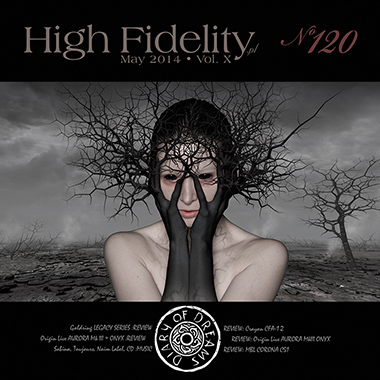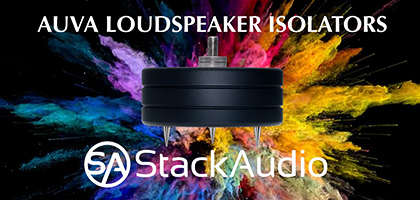No. 258 November 2025
- COVER REVIEW: BLADELIUS Oden II Class-A ⸜ integrated amplifier » SWEDEN
- INTERVIEW: "The Editors" series № 37: ANDREW SIMPSONS • Audiograde ⸜ editor-in-chief » UNITED KINGDOM
- TECHNIQUE: digital recorders: DENON PCM part 2 - DN-23R tape recorder || 1972-1974 » JAPAN
- REVIEW: ACOUSTIC REVIVE RTP-4EU Final ⸜ AC power strip » JAPAN
- REVIEW: AUDIO REVEAL Classic ⸜ integrated amplifier » POLAND
- REVIEW: FOUND SOUND DAVIO Davio Azure ⸜ digital-to-analogue converter » POLAND
- REVIEW: LAIV Harmony GaNM ⸜ power amplifier • monoblocks » SINGAPORE
- REVIEW: WARAN AUDIO Lava ⸜ AC power cable » POLAND
- MUSIC ⸜ Our albums series: ASTOR PIAZZOLA AND HIS TANGO QUINTET, Live in Lugano 1983, Ermitage/AudioNautes Recordings, Ultimate HiQualityCD


|

|
|
A CONCERT AT HOME -
what a beautiful disaster! 
 
Do you still remember the home cinema craze? It’s hard not to remember, isn’t it? The promise was that it didn’t take a lot of time and money to change a room in your house into a cinema and get even a better experience than at a real movie theater, all without leaving home and putting yourself at risk of sitting next to other people who talk loudly and eat popcorn. That’s how people were lied to. I’m not saying that all the home cinema manufacturers were deceptive, but most of them. And people like to be deceived. People in Krakow say that the first home cinema system in Poland was made by Hans Frank. This German war criminal became the governor-general of occupied Poland’s ‘General Government’ territory on October 26th, 1939, after the German invasion of Poland. He made Krakow’s Wawel castle his residence that he moved into on October 7th, 1939. It was there, in the same royal rooms that were once home to Polish kings and knights, that the man organized private film showings. Everyone who went through this “disease” knows that “home cinema” has about as much to do with a real cinema as a “sports car” with Formula 1. It’s just a certain convention – one is meant to be a good imitation of the other. But they are still two separate realities. In any case, home cinema quickly degenerated in a flood of dirt cheap all-in-one “systems” from China. 
This was a concert I had been impatiently waiting to see. On March 20th, the Crimson ProjeKCt played in Klub Studio in Krakow. They are official heirs to King Crimson, having the full approval of Robert Fripp, the brain behind this rock legend (see HERE). The band consists of King Crimson’s former members who played on its best albums, like Discipline and the two following “colorful” discs, as well as Thrak: Adrian Belew (vocals, guitars, guitar synthesizer), Tony Levin (vocals, bass, chapman stick) and Pat Mastelotto (drums). During their live tour, the ProjeKCt grew by three instrumentalists – Markus Reuter (touch guitar), Julie Slick (bass) and Tobias Ralph (drums). All six musicians perform together as a band, in two interchangeable trios, as well as solo. In addition to King Crimson tracks, the band also performs compositions from the albums of bands like Stick Men, which Tony Levin is a part of. 
The concert in Krakow was phenomenal. Unfortunately, the space between rows of chairs was ultra-minimal, and a bunch of Czech guys sat in front me, my son and my friend. One of them insisted on sitting with his legs extended in front of him, but it didn’t stop us from listening to what came from the stage in a state that neared ecstasy. In defense of the Czech guys (well, they were speaking Czech), they were no longer in their prime, which could actually be said about a large part of the audience, so their joints might be a little rusty. But besides some minor motor impairments, the audience gathered in the Studio showed the kind of musical taste that seems more fitting for guys with hair down to their knees who listen to music where the bass pedal hits 160 times per minute. Six of the people on stage (two drum sets!!!) played seemingly well-known tracks, but with the fiery passion you’d expect from a thrash-metal concert. Tony Levin’s chapman stick and Julie Slick’s bass (holy hell, the girl has fantastic power!) literally thrust me down into the already-wobbly chair. To be honest, I think that the soundscapes played by Markus Reuter on his custom-designed U8 Deluxe Touch Guitar were the weakest part of the performance. The guy is a genius and a fantastic musician, but only when his instrument is telling a story as part of a band. 
The most important thing was BEING THERE, at the concert of a band I love and listening to the tracks I dream about. Watching a live performance stimulates all our senses, not only our hearing as listening to an album does, or our hearing and sight in the case of watching a concert on Blu-ray. So it’s no surprise that audio component designers attempt to bring this experience into our homes. And that’s usually how their products are advertised, as something capable of replaying a stage experience. 
Coming back home before midnight, I immediately put on my headphones and placed Thrak on my CD player. The disappointment was huge, even though I knew what to expect. Live recordings are even worse in that respect. The reason for such a wide gap between an on-stage event and its recording lies at its very basis – in the way that concerts are recorded. With classical music recordings, microphones are placed around the stage so that they pickup certain instruments better. |
The best recordings use a small number of microphones, and particular tracks are only minimally modified. Many jazz concerts are recorded this way, too. But rock concerts and some jazz performances are recorded using completely different techniques. The sound that we hear from our speakers (or headphones) has very little to do with what is heard on-stage. The reason for that is that the sound, although recorded by microphones set up next to the instruments or around the room, is treated in a specific way. The signal from vocals microphones as well as those recording guitar amps and drums is split into two lines (actually three, to be precise, as there’s also the monitoring system, but that’s not the point here). One of them is fed to the mixing console, manned by the sound engineer in charge of the concert mix, while the other one goes to the console in a recording room. Each of them is processed in a different way, i.e. with different levels of particular recording tracks, different reverb, tone control, dynamics, etc. Sometimes the signal for the recording is taken from the main console, after mixing, but it’s rare and the effects aren’t usually very good. Hence, an album brings a different interpretation of what happened on the stage to the one experienced at the concert. Many bands additionally cleans the tracks, improving the vocals, guitars and mixing in additional instruments. 
That’s why trying to bring a concert experience to your home is like a “witch trial” – it has no right to succeed. So what do we do, then? Do we throw out all live recordings? That’s certainly an option. I don’t have too many of them, anyway, and I’m not too fond of them. I know how much I’m missing. There is a chance of saving some of the emotions, though, of creating something that “resembles” a concert in your home. But that’s only if you don’t expect to “move” the performance into your house (which is impossible), and agree to create something new, a kind of recording engineer’s vision of what happened on that day. Then it makes sense. Of course it will lack most of live event emotions, as it’s not the same thing as experiencing music together, and there’s no chance of getting a comparable sound pressure level (volume) or its physical sensation. But you will hear WHAT and HOW the vocalist sings. There’s even a chance that you’ll be able to create a sound that evokes completely new emotions, different than those at the concert yet being their “home” counterpart. And then you can be blown away, too. 
(During the concert Tony Levin took photos that he later published on his blog – one of the longest-running music blogs. You can actually see me and my friend on one of them. Who can find us? See the photo HERE | I’m sorry for the bad image quality – the bouncers at the entrance strip me of my camera, saying that it’s “too professional” and forgetting that these days even the smallest cameras can be used for professional work; the photos were taken with a Samsung Core Duo). Więcej na: "Heavy Rock"  Diary of Dreams 
This Limited Edition album has a run time of 74:44. That’s a whole, whole lot. Whenever I get a chance I try to emphasize that in a perfect world an album would spin between 31 and 41 minutes. If it’s any longer, it should be a two-disc release. Otherwise it just gets tedious. But things are different with Elegies in Darkness, the 11th album by the German band Diary of Dreams. 
Musically-speaking, this is one of the band’s better albums. Kept in the same convention they worked out on Nekrolog 43, (If) and Ego:X, it contains the music that is full of melancholy, with some really epic moments. Tracks are usually composed in the following manner: an atmospheric, mysterious intro played for example on the grand piano that moves to a more powerful passage with choirs, strong guitars and louder drums, before getting quiet again. The guitars aren’t as one-sided as before and often sound different than what we’re used to. 
I think that the refined album production was part of creating such a dense and intensive mood. DoD’s albums differ significantly between one another in terms of sound production quality. I’m fully aware that their die-hard fans believe otherwise, saying that each album sounds spectacular, at the very least. But the truth is different. Many of Hates’ productions are so compressed and overdriven that the chaos erupting in the louder passages is simply uncanny. Another problem is a not fully transparent treatment of DoD’s frontman’s vocals. They are hidden in the mix and yet “jump out” from time to time due to some overly emphasized sibilants. 
Track list: Sound quality: 7-8/10 |
About Us |
We cooperate |
Patrons |
|
Our reviewers regularly contribute to “Enjoy the Music.com”, “Positive-Feedback.com”, “HiFiStatement.net” and “Hi-Fi Choice & Home Cinema. Edycja Polska” . "High Fidelity" is a monthly magazine dedicated to high quality sound. It has been published since May 1st, 2004. Up until October 2008, the magazine was called "High Fidelity OnLine", but since November 2008 it has been registered under the new title. "High Fidelity" is an online magazine, i.e. it is only published on the web. For the last few years it has been published both in Polish and in English. Thanks to our English section, the magazine has now a worldwide reach - statistics show that we have readers from almost every country in the world. Once a year, we prepare a printed edition of one of reviews published online. This unique, limited collector's edition is given to the visitors of the Audio Show in Warsaw, Poland, held in November of each year. For years, "High Fidelity" has been cooperating with other audio magazines, including “Enjoy the Music.com” and “Positive-Feedback.com” in the U.S. and “HiFiStatement.net” in Germany. Our reviews have also been published by “6moons.com”. You can contact any of our contributors by clicking his email address on our CONTACT page. |
 



|
   |
main page | archive | contact | kts
© 2009 HighFidelity, design by PikselStudio,
projektowanie stron www: Indecity







 atej Isak (“Mono&Stereo”): Is there specific company audio/sound approach or do you tend to be neutral sounding?
atej Isak (“Mono&Stereo”): Is there specific company audio/sound approach or do you tend to be neutral sounding?


